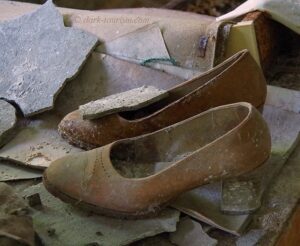The media are awash with special programmes and articles about the first anniversary of the start of Putin’s war against Ukraine, so I thought I can’t leave this sad day unmarked either.
My initial devastation and panic in the first few weeks of the war (or “special military operation” in Putin Newspeak), especially with the first of his nuclear threats, has somewhat subsided as reporting about the war has become “normalized”, as it were, and the nuclear threats have proved to be the mere bluffing Putin said it wasn’t. But I’m still quite affected by it all – and the fact remains that several chapters of my book are now outdated. However, I have been able to put a few updates in it for the second print run.
This war has also had its repercussions in the world of dark tourism as such. Not only is Ukraine off the tourism radar (for ordinary mortals at least) and Russia is unsuitable for Westerners too at the moment, there’s also a kind of perception change. I know a tour operator who offered tours of Chernobyl, now obviously impossible, as well as specialized post-socialist architectural tours of the Balkans. Now any expression of an interest in such things can be misinterpreted as being pro-Russian. And that can lead to nasty communication breakdowns.
Meanwhile Ukraine has intensified its iconoclasm against Soviet-era monuments, and it’s not alone (Bulgaria, for instance, is another case in point). The featured photo above shows the gigantic Rodina Mat statue (with three WWII-era guns in the foreground that are part of a war memorial complex). It’s the No.1 Soviet-era landmark of Kyiv, erected in the Brezhnev era. But its symbolism – tying Ukraine to Moscow, basically – makes it a possible target for big-style iconoclasm in the future. I do hope they won’t tear down this marvel of socialist-era monumentalism, but if they did I wouldn’t be totally surprised.
Again, though, I’d like to point out that I feel as sorry for Russia as I do for Ukraine, as I’ve made clear at length in this post from last March. I do hope that there will come the day when both Ukraine AND Russia can become the worthy travel destinations again that they used to be until a year ago.
But right now I still see no solution. I fear that my early hunch that this will turn into a lengthy war of attrition is proving correct. And it’s causing a brain drain in Russia too. When I was in Cyprus this January I actually met one young Russian guy who had recently fled from his homeland because of the war (and he did say “war”, not stupid “special military operation”!).
Speaking of Cyprus, I’ve made considerable progress with my coverage of the country (or countries, plural, if you count North Cyprus as a separate one) on my main website. In fact all the chapters for South Cyprus are already uploaded. Do take a look!
Coverage of the TRNC is still a work in progress, though the most important chapters, the one on the ghost town of Varosha and the one on North Nicosia, are already there. The remainder will follow soon. I’m confident that I’ll have finished those before that feature about me and dark tourism comes out in the Cyprus Mail in early March. I’ll provide the link here when the online version is available.
Already available is an earlier interview that I did with that expat Russian bloke who took me to see the Mitsero Mines and Kokkinotrimithia when I was over in Cyprus in January. Here’s the link (external link, opens in a new tab). It’s in Russian, so readers who don’t know that language will have to put it through an online translation service, the easiest being Google Translate if you’re using Chrome as a browser (simply follow the translation prompt or right-click and select “translate to English”). It gets a few lexical things wrong, e.g. calling the Imprisoned Graves “Arrested Graves”, and the title of my book is also sometimes wrong (though I quite liked “Atlas of Dark Directions”), but overall it’s pretty close to the original. I have also put the original interview, which was conducted in English, on my website (but there you don’t get the photos, but extra links – and if you compare the two texts you’ll also see some small edits they made for the Cyprus Butterfly website).
The text also erroneously claims that my book “became a bestseller in many countries”. I wish that was so, yet even if the first print run of 8000 copies has sold out, that hardly makes it a bestseller. But who knows, maybe this Cyprus Butterfly feature (and the next one in March in the Cyprus Mail) may help sales numbers along a bit. And if you read this and haven’t yet obtained a copy, you too can do your bit to support it (and, in turn, me).
So much from me on this dark day …
.
.
.




